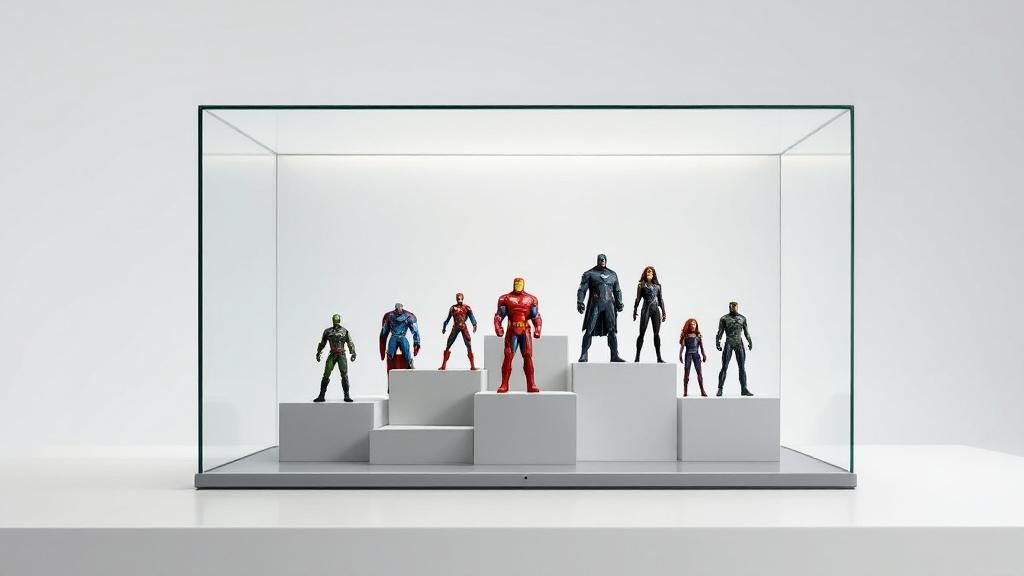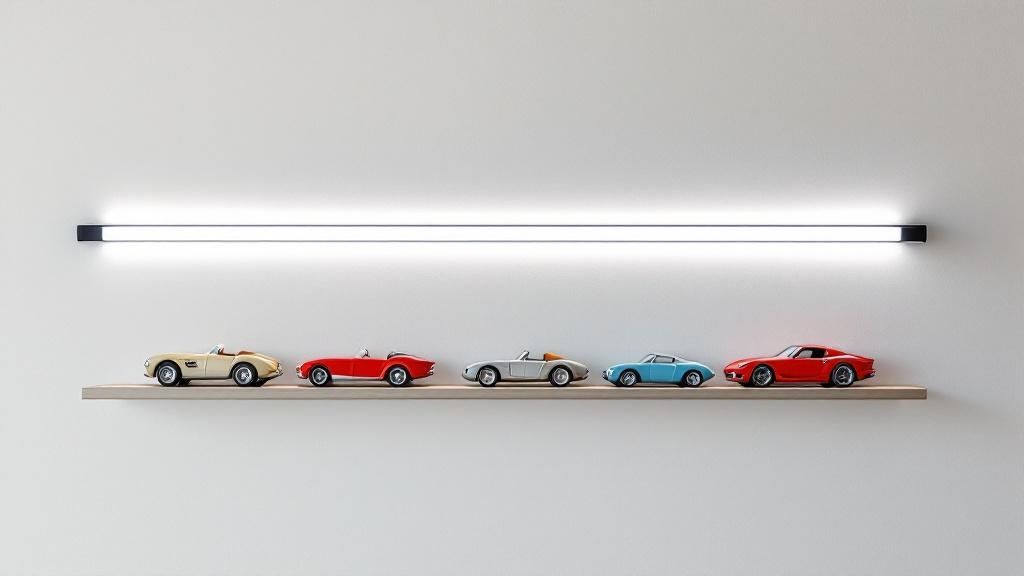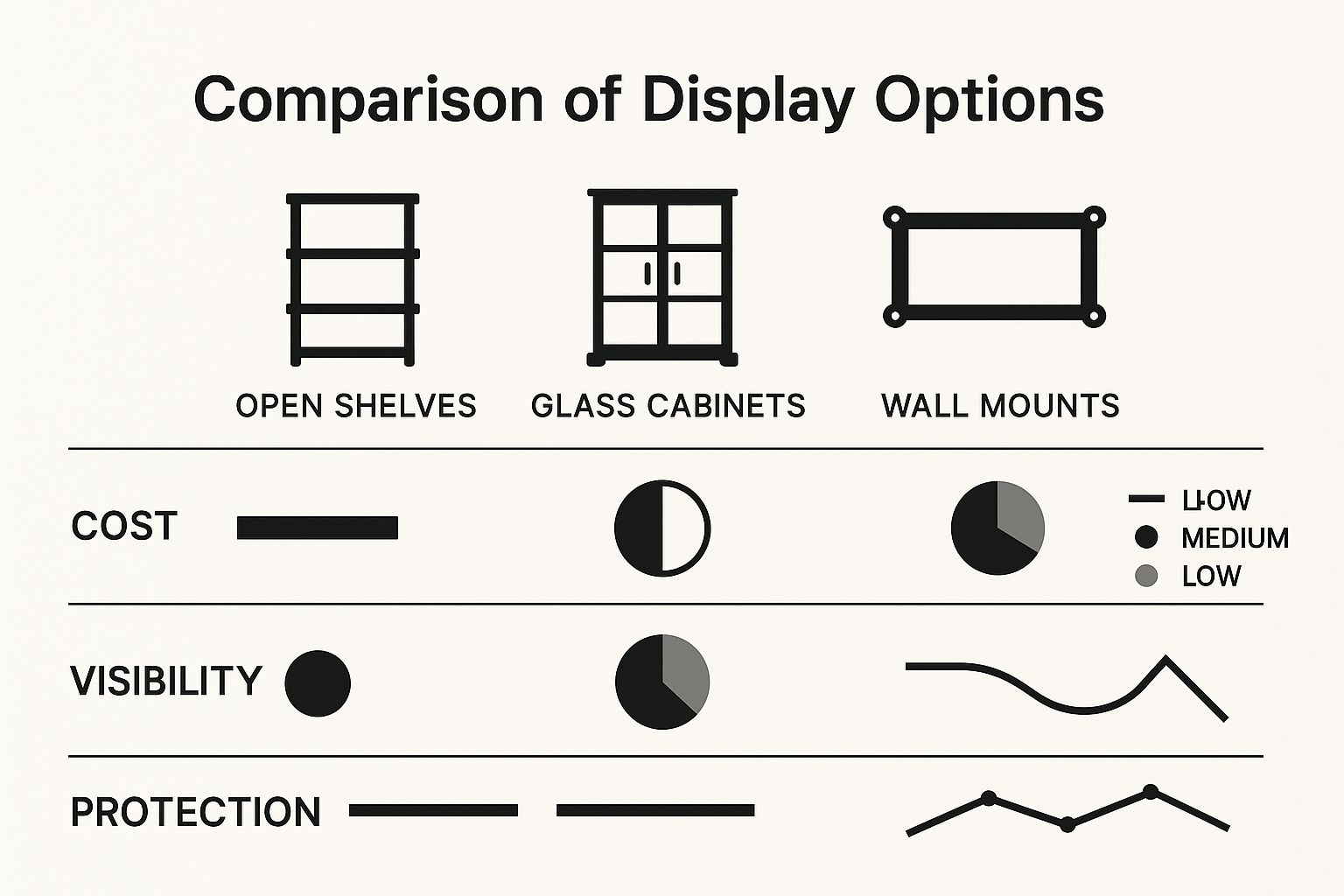The way you display your collectibles can be the difference between a cluttered corner and a personal museum. It’s about more than just putting things on a shelf; it’s about creating a narrative, finding the right location, and selecting furniture that truly highlights each piece. This is how you transform a passion project into a captivating visual story.
From Passion Project to Curated Exhibit

Your collection is a physical representation of your passion, and it deserves to be shared. The first real step in learning how to display collectibles is a mental one: you need to stop thinking like a hobbyist and start thinking like a curator. It’s a shift from just storing your items to intentionally crafting a visual narrative for anyone who walks into the room.
This change in perspective is what unlocks a collection's true potential. For years, my own collection just felt like clutter taking up space. It wasn't until I started treating it like a personal exhibit that it became a more engaging and meaningful part of my home.
Establish Your Narrative
Every great display begins with a story. What tale do you want your collection to tell? Deciding on a theme gives you a guiding principle for every other choice you'll make, from placement to lighting.
- Chronological Order: This is a classic for a reason. Arranging items by their release date shows their evolution over time, which works wonderfully for vintage toy lines or historical memorabilia.
- Thematic Grouping: You can create powerful mini-exhibits by grouping items by character, series, creator, or even a specific event. This creates focused, cohesive clusters within your larger collection.
- Aesthetic Harmony: Sometimes, the story is purely visual. Arranging pieces based on color palettes, shapes, or materials can result in a display that feels more like an art installation.
When you choose a narrative, your display feels intentional and thoughtfully designed, not like a happy accident.
A curated collection is a conversation starter. When you display items with a clear story, you invite people to ask questions and engage with your passion on a deeper level.
Find the Perfect Space
Once you have your story, you need to find the right stage for it. Walk through your home and consider where the collection will have the most impact. Pay attention to foot traffic, natural and artificial light, and how the display will fit with the room's existing decor.
The goal here is seamless integration. You want the collection to feel like a sophisticated and natural extension of your living space. This thoughtful placement is what elevates a simple shelf of items into a truly curated exhibit.
This trend toward personal curation reflects a booming market. The global collectibles market was valued at USD 294.23 billion in 2023 and is projected to reach an incredible USD 422.56 billion by 2030. You can explore more about this market growth on Grand View Research.
Crafting Your Display Strategy

Before you even think about moving a single piece, the most powerful tool you have is a solid plan. This is what truly separates a random pile of cool stuff from a thoughtfully curated exhibit. It all starts with taking a good, hard look at what you actually own and understanding the unique needs of each item.
First things first, get a handle on your inventory. Group your collectibles by their physical traits—size, weight, and what they're made of. A heavy set of bronze bookends, for instance, is going to need a much beefier shelf than a few delicate glass figurines. Think about fragility, too. Anything that could easily chip or break should be kept far away from high-traffic zones or tucked safely behind glass. Signed memorabilia or other high-value pieces? They deserve special placement to avoid any accidental bumps or knocks.
Getting this part right from the beginning prevents those heartbreaking and often expensive mistakes later on. It’s all about making sure your display is both safe and perfectly suited for your treasures.
Telling a Story With Your Collection
Once you have a clear inventory, you can start thinking about the story you want to tell. A narrative gives your display a sense of purpose and pulls everything together into a cohesive whole. It's the theme that connects each piece. From my experience, most collectors find success by taking one of a few key approaches.
Here are a few popular ways to structure your display's narrative:
- Go Chronological: Arranging items by their release date or historical era is a fantastic way to show the evolution of a brand, an artist, or a series. This works wonders for collections like vintage toys, classic cameras, or even old media formats.
- Group by Aesthetics: Sometimes, the story is purely visual. Grouping items by color, shape, or texture can create a striking artistic effect. Imagine a shelf of vintage Pyrex bowls arranged in a beautiful rainbow gradient—it’s pure eye-candy.
- Organize by Category: For large collections, sorting by character, series, or creator provides a clear, logical structure that’s easy for anyone to understand. This is a go-to method for huge assortments of action figures, comic books, or designer art toys.
Don't feel pressured to put everything out at once. A carefully curated selection often has a much stronger impact than a cluttered, overcrowded shelf. Rotating your pieces is a great way to keep the display feeling fresh and lets you rediscover your favorites.
Picking the Perfect Spot
The final, critical piece of the puzzle is location. Where you display your collection is just as important as how you arrange it. The number one enemy for many materials, especially paper and plastics, is direct sunlight. UV rays cause irreversible fading and can make plastics brittle and weak over time.
Because of this, you’ll want to choose a spot away from windows that get a lot of intense, direct sun. Also, consider the flow of traffic in the room. A busy hallway is probably not the wisest choice for your most delicate or wobbly pieces. The goal is to find a home for your collection where it can be admired without being in constant peril.
Finally, think about how the display will fit in with your home's existing style. Does the shelving you’ve chosen complement the room’s furniture? Does the color palette of the collection work with the paint on the walls? Taking a moment to answer these questions helps ensure your display becomes a true feature of your living space—one that feels both deeply personal and expertly put together.
Choosing Furniture That Complements Your Collection
The furniture you choose is far more than just storage—it’s the stage where your collection truly shines. Moving past generic shelving is the first step toward creating a display that feels both deliberate and impressive. The right piece can transform a simple assortment of items into a curated exhibit, but the trick is to match the furniture's function and style to the unique needs of your collectibles.
Before you even think about aesthetics, consider the practical demands of your items. A collection of heavy, vintage vinyl records, for example, needs a deep, sturdy bookcase that can handle that weight without bowing over time. In contrast, showcasing graded comic books or delicate figurines requires a completely different approach. Here, something like museum-style acrylic risers on a stable surface can create a clean, floating effect, highlighting each individual piece without any visual clutter.
Open Shelves Versus Enclosed Cabinets
One of the first big decisions every collector faces is whether to go with open shelving or enclosed cabinets. Each has its own set of pros and cons that can dramatically affect both the look and the long-term preservation of your collection.
Open shelves are fantastic for accessibility and make it incredibly easy to rotate items, keeping your display fresh. The downside? They are a magnet for dust and offer absolutely no protection from accidental bumps, curious pets, or visiting children.
On the other hand, enclosed glass cabinets provide top-tier protection from dust, pests, and physical damage. This makes them the clear winner for anything fragile or high-value, like antique porcelain, signed memorabilia, or delicate models. Just be aware that glass can create glare under certain lighting and will need regular cleaning to stay free of fingerprints.
Comparing Display Furniture Options
To make the decision a bit easier, it helps to see the options laid out side-by-side. This table breaks down the most common choices, comparing them based on what they protect, how they look, and which collections they suit best.
| Furniture Type | Best For | Protection Level | Visibility | Style |
|---|---|---|---|---|
| Open Bookshelves | Books, vinyl records, sturdy figures | Low | High | Versatile (Modern, Rustic, etc.) |
| Floating Shelves | Small, lightweight items, art prints | Low | High | Minimalist, Contemporary |
| Glass Curio Cabinet | Fragile antiques, memorabilia, models | High | High (with potential for glare) | Traditional, Classic, Ornate |
| Acrylic Cases/Risers | Single high-value items, graded cards | Medium to High | Excellent | Modern, Unobtrusive |
| Wall-Mounted Grids | Action figures (in-box), tools, pins | Low | High | Industrial, Utilitarian |
Ultimately, the right furniture strikes a balance between showcasing your items and keeping them safe. Think about your priorities—is it all about visibility, or is long-term preservation your main goal? Your answer will guide you to the perfect fit.

Matching Materials to Your Collection’s Mood
The material of your display furniture does so much to set the tone. It can define the atmosphere of the entire room and should feel like a natural extension of your collection's story.
- Reclaimed Wood: This option brings a warm, rustic, and timeless feel. It pairs beautifully with historical artifacts, vintage books, or rustic metallic collectibles.
- Industrial Metal: For a modern, edgy, and durable framework, metal is hard to beat. This material is perfect for displaying industrial-era items, modern art toys, or creating a stark, minimalist look.
- Sleek Acrylic: When you want the collectibles to be the undisputed star of the show, acrylic delivers a contemporary and almost invisible solution.
Think of your furniture as part of the narrative. An antique wooden curio cabinet tells a completely different story than a sleek, wall-mounted metal shelving system. Choose the one that best communicates the spirit of your collection.
This principle of blending style with function is universal, applying to any specialized space in your home. When designing a recreational area, for instance, picking the right pieces is just as important. You can see more of these concepts in action in our guide to top home game room ideas to elevate your space. By thoughtfully considering function, protection, and material, your furniture will become an integral part of your display, not just a place to put things.
Arranging Your Items for Maximum Impact

With your display furniture set up, the real fun starts. Styling your collection is where your inner curator gets to shine, blending thoughtful organization with a bit of creative flair. It’s about transforming a simple lineup of items into a dynamic display that tells a story and guides the eye.
The last thing you want is a flat, monotonous row of objects. Your goal is to create visual rhythm. One of the simplest and most effective ways I've found to do this is by playing with height. Introducing different vertical levels instantly makes a display feel more organic and interesting, encouraging people to lean in and appreciate each piece.
Create Visual Interest with Height and Grouping
Varying the height within your display is a surprisingly powerful strategy. You don’t need anything fancy; clear acrylic risers work wonders for elevating smaller items. A common practice is to place taller pieces toward the back and shorter ones in front, which immediately creates a sense of depth and ensures nothing gets lost in the shuffle.
Imagine you're setting up a shelf of Funko Pops. By placing a few rare or personally significant figures on risers behind the others, you create a natural focal point and a visual hierarchy. The same logic applies to ephemera like vintage postcards; layering them in a shadow box, with some closer to the glass, adds a compelling three-dimensional quality.
Another trick from the world of interior design is the “rule of threes.” This principle suggests that items arranged in odd-numbered groups—especially threes—are more aesthetically pleasing and memorable. It’s a fantastic way to create small, contained vignettes that feel both balanced and intentional.
Grouping items by a common theme—be it color, size, or era—is what makes a collection look purposeful rather than random. It creates a visual cohesion that's incredibly satisfying to look at.
This approach helps you sidestep the cluttered look that happens when you try to give every single item its own spotlight. For example, instead of lining up ten small ceramic figurines, try picking three that work well together and arrange them in a tight cluster. You’d be amazed at the difference such a small change makes.
Crafting a Balanced Composition
Achieving balance is key to a display that feels stable and harmonious. This doesn't mean you need perfect, mirror-image symmetry. It’s more about distributing the "visual weight" of your items so the whole scene feels right. You can accomplish this by artfully mixing objects of different sizes, textures, and shapes.
Here are a few tips I always come back to when composing a shelf:
- Establish a Focal Point: Choose one large or particularly striking item to act as the anchor for your display. Then, arrange smaller, complementary pieces around it to build out a balanced scene.
- Embrace Negative Space: Don't feel the need to fill every last inch. Leaving some empty space, or "breathing room," is crucial. It reduces the sense of clutter and gives each piece the space it needs to be appreciated individually.
- Layer from Back to Front: This is a classic for a reason. Start with your tallest items at the back of the shelf. Next, add medium-sized objects in the middle, and finish with your smallest or most detailed pieces right at the front, where they can be seen up close.
These principles of careful arrangement apply to almost anything, even items that blend function and form. A beautiful marble chess set, for instance, is both a game and a work of art that deserves thoughtful placement. If you have such a set, learning more about proper chess set storage can offer more ideas for keeping it safe while still showing it off.
By applying these styling techniques, you can elevate your collection from mere storage into a truly curated exhibit.
Effective Lighting and Preservation Methods
https://www.youtube.com/embed/-STQqhA4W2k
Great lighting can transform a collection from something you own into something you experience. But get it wrong, and you could be slowly destroying the very treasures you’re trying to showcase. The trick is to treat light as both a design element and a crucial preservation tool.
The absolute best choice for this is the Light Emitting Diode (LED). Forget old-school incandescent or halogen bulbs that cook your collectibles with heat and bombard them with damaging UV radiation. LEDs run cool and emit virtually zero UV, which is why they've become the standard for professional archivists and serious collectors alike.
Their versatility is a huge plus. You can tuck adhesive LED strips along the inside edge of a bookshelf to wash your display in a soft, even glow. Or, you can use a single, focused LED spotlight to make a prized statue the undisputed hero of the room. It’s all about creating drama and guiding the viewer’s eye.
Essential Preservation Strategies
Beyond just lighting, protecting your collection for the long haul means thinking about the environment it lives in. Light is a major culprit, but so are humidity, dust, and even the oils from your hands. Materials like paper, wood, and certain plastics are especially vulnerable.
For your most valuable or fragile pieces, a protective case is non-negotiable. Don't just grab any clear box; specifically look for ones made from UV-filtering acrylic. This material is a game-changer, blocking over 98% of harmful UV rays that cause colors to fade and materials to break down. It gives you the crystal-clear view of glass without the risk.
Think of preservation not as a chore, but as an integral part of the hobby itself. A well-preserved collection maintains its emotional and financial value, ensuring it can be enjoyed by you and others for years to come.
Managing Humidity and Cleaning Routines
Humidity is the unseen enemy of many collections. It can make paper comics brittle, warp wooden figures, and invite mold to grow on just about anything. You can easily keep an eye on this with a simple digital hygrometer. The sweet spot you're aiming for is a stable relative humidity between 45-55%.
Finally, a simple, consistent cleaning routine will prevent the slow damage caused by dust, which is surprisingly abrasive.
- Smooth Surfaces: A soft microfiber cloth is your best friend for wiping down display cases, shelves, and the collectibles themselves.
- Intricate Items: For detailed models or figures with lots of nooks and crannies, a clean, soft-bristle makeup brush or a can of compressed air works wonders. Just be sure to use short bursts from a distance.
- Special Materials: Some items demand unique care. For instance, knowing how to clean marble properly can prevent permanent stains or etching.
Taking these steps isn't just about personal pride; it's a smart move. The second-hand collectibles market is booming, valued at a staggering USD 142.5 billion in 2024 and expected to nearly double by 2034. You can discover more insights about this collectibles market growth to see just why protecting your collection is also a wise investment.
Answering Your Top Questions About Displaying Collectibles
Even the most meticulously planned display comes with its own set of practical, day-to-day questions. If you've ever felt a little overwhelmed by the upkeep, you're not alone. The good news is that the solutions are usually straightforward once you know the tricks of the trade.
Let's walk through some of the most common questions I hear from fellow collectors. From dusting to dealing with an ever-expanding hoard, these answers will help you handle your collection with the confidence of a seasoned pro.
How Do I Dust Delicate or Complex Collectibles?
This is probably the number one concern for anyone with intricate pieces. How do you clean a detailed model ship, a complex LEGO build, or an ornate figurine without snapping off a tiny, irreplaceable part? The key is a gentle touch.
Your best friend here is a simple can of compressed air. Holding it at a safe distance and using short, controlled bursts, you can blow dust out of the deepest crevices without ever making contact. For the surfaces you can easily reach, a soft-bristle makeup brush or a high-quality microfiber cloth will do the job beautifully.
One piece of advice I always give: stay away from traditional feather dusters. They're notorious for snagging on small parts and tend to just shuffle dust around, which can lead to fine scratches over time.
What’s the Best Way to Display a Growing Collection?
It’s a great problem to have, but as your collection grows, it’s easy to cross the line from a curated exhibit to just… clutter. The secret isn't finding more space; it's being selective about what you show at any given time. Think like a museum curator and embrace rotation.
Start by choosing a core group of your absolute favorite or most significant pieces to be the stars of your main display. Everything else can be stored safely, ready for its turn in the spotlight. This approach has a few fantastic benefits:
- It keeps your display feeling fresh. Swapping items out seasonally or when you get a new "grail" piece makes your collection feel dynamic and exciting.
- It prevents a cluttered look. Giving each item its own "breathing room" allows it to be properly seen and appreciated.
- It makes the most of your space. You can use vertical solutions like tiered stands to layer your display, getting more visual impact from the same shelf without it feeling crowded.
This strategy ensures your display always looks intentional and well-composed, no matter how many treasures you have tucked away.
Are There Budget-Friendly Alternatives to Expensive Cases?
Absolutely. You don't have to spend a fortune to protect and showcase your collection beautifully. While a museum-grade case is a smart investment for truly priceless items, there are plenty of creative and affordable options for the rest of us.
This is where you get to think outside the box. Simple, clear acrylic risers or plate stands are incredibly cheap and work wonders for adding height and dimension to a standard bookshelf display. The IKEA DETOLF glass cabinet is practically a legend in collecting circles for a reason—it offers 360-degree visibility and a clean look for an unbeatable price.
You can also get creative by repurposing everyday items. Wall-mounted picture ledges are perfect for displaying boxed action figures, vinyl records, or graphic novels. I’ve even seen people turn spice racks into fantastic tiered displays for tiny figurines. A little ingenuity can go a long way toward creating a setup that looks sophisticated and keeps your items safe, all without breaking the bank.
At MarbleCultures, we believe that the items you love deserve to be displayed with elegance and care. Discover our curated collection of artisanal game sets and decor that can serve as the stunning centerpiece of your display. Explore our offerings at https://marblecultures.com.

